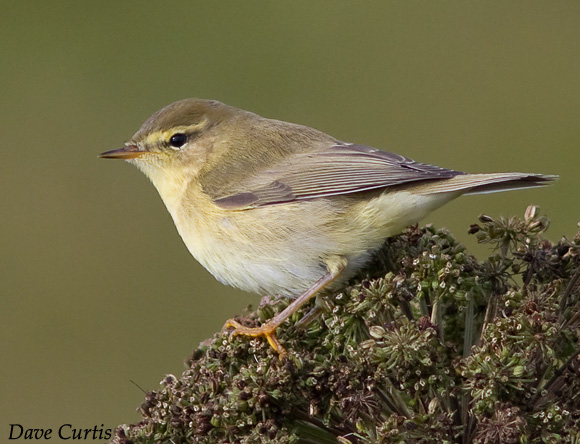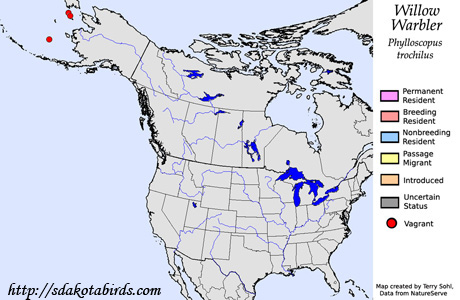| Length: 4.5 inches | Wingspan: 7.5 inches | Seasonality: Non-resident in South Dakota |
| ID Keys: Gray upperparts with greenish tinge, very pale buffy underparts, plain wings with no wingbars, pale eyebrow and indistinctive darker eye stripe | ||
 The
Willow Warbler is a common "leaf warbler" species that is found throughout
much of Europe and Asia. The breed from the United Kingdom on the west all
the way eastward through Siberia. In North America, they are rare
vagrants in two locations, with a number of sightings on both St. Lawrence
island and the Pribilofs in the Bering Sea.
The
Willow Warbler is a common "leaf warbler" species that is found throughout
much of Europe and Asia. The breed from the United Kingdom on the west all
the way eastward through Siberia. In North America, they are rare
vagrants in two locations, with a number of sightings on both St. Lawrence
island and the Pribilofs in the Bering Sea.
Habitat: Found in a variety of open woodland habitats, as well as forest edges and clearings, tree plantations, and wooded park land. A common attribute of many habitats is an understory component of scattered thickets and shrubs.
Diet: Feeds on insects and spiders. They will also feed on berries, particularly in the fall.
Behavior: Actively forages in the woodland understory, moving through foliage in search of insects. Food items are gathered through direct gleaning from vegetation, or by flycatching in short flights.
Nesting: The nest of a Willow Warbler is a dome made of mosses, lichen, grasses, and other vegetative material, with an entrance placed on the side. It is placed on the ground or very low in vegetation. The female lays 5 to 7 eggs, which she alone incubates. The young hatch after about 14 days, and both parents help raise and feed the young. The young fledge about 2 weeks after hatching.
Song: The song of a Willow Warbler is a repetitive descending warbling.
Migration: Strongly migratory. Birds breed throughout much of Europe and northern Asia. In winter, the species migrates to central and southern Africa. Birds that summer in Siberia make one of the longest distance migrations of any bird of a similar size, up to 8,000 miles.
Interactive eBird map: Click here to access an interactive eBird map of Willow Warbler sightings
Similar Species: In the Old World, may be confused with a number of leaf-warbler (Phylloscopus) species.
Conservation Status: Populations appear to be in decline. However, they are still found over a very wide geographic area and are common in many locations. The Willow Warbler is considered a species of "Least Concern" by the IUCN.
Further Information: 1) BirdLife International - Willow Warbler
2) Arkive.org - Willow Warbler
3) Whatbird - Willow Warbler
Photo Information: Photo by Dave Curtis - September 14th, 2011 - Shetland Islands, Scotland, United Kingdom - Photo licensed under Creative Commons Attribution NonCommerical NoDerivs 2.0 Generic license.
| Click below for a higher-resolution map |
 |
| South Dakota Status: Non-resident in South Dakota |
Additional Willow Warbler Photos (coming soon!!)
